What to See in Kotor, Montenegro — Top-10 Tourist Attractions (According to Historian and Resident of Montenegro Nikolai Stepanov)
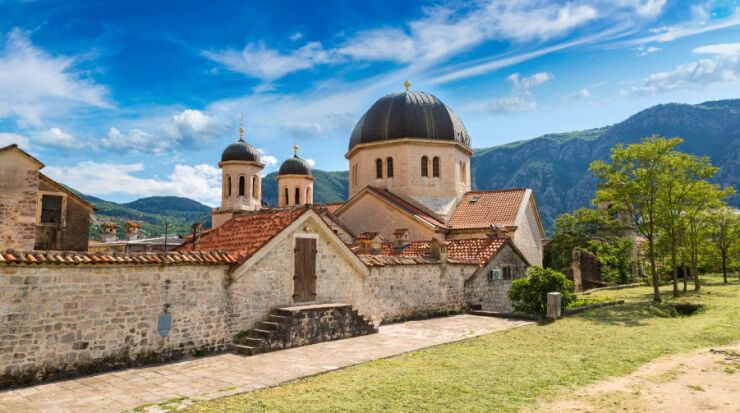
Old Kotor and its fortress are perhaps the most popular attractions in Montenegro. It is at the roadstead of Kotor that numerous cruise ships dock, as all other cruise companies, a visit to Kotor is included in the compulsory programme.
Suppose you arrive on a cruise ship in the city... What can we recommend for those who only have a day (5-6 hours) in Kotor? In my opinion, according to observations and reviews from tourists, it is these three places in Kotor that take tourists 200-300 years back; it is in them that you can understand Kotor and feel its history.
- First of all, you need to enter the Kotor Fortress through the Main (Sea) Gate and without rushing to drink coffee on the Square of Arms, which you will see immediately after the Sea Gate. The Square of Arms and the Main Gate are the real faces of Kotor.
- If you are not afraid of thousands of stone steps, climbing to a height of 230 meters and you have 3-4 hours of free time, climb the city walls to the fortress of San Giovanni (Fort of St Ivan), from there you can see breathtaking views of the bay.
- But the soul of Kotor can be felt under the ringing of the bells on Cathedral St Tryphon Square, where the Catholic church of the same name dedicated to the patron saint of the city is located.
I recommend visiting the following attractions, since, from my own experience, they are most popular with city guests, are conveniently located, can be visited in a day, and are accessible to tourists with any form of physical fitness. The exception is Mount Pestingrad; to hike this rock you need to have experience in hiking and a whole free day. But it’s worth it; the views from Pestingrad are magnificent.
Contents
History of Kotor
Population and Mentality of Residents in Kotor
Main Disadvantage of Kotor
Transportation Problem
Architecture of Kotor
Attractions and Places of Interest in Kotor
1. The Gates of Old Kotor
2. The Castle of San Giovanni
3. Boka Kotor Bay
4. Pestingrad Rock Massif
5. Citadel (Campana Bastion)
6. Cathedral of St Tryphon
7. Square of Arms
8. Clock Tower and Pillar of Shame
9. Napoleon’s Theater
10. Cats Museum
The Map of Attractions in Kotor
Conclusion
History of Kotor
The history of Kotor starts from Roman times. It is considered that the Romans were the first to build their forts here. After the Roman Empire collapsed the owners of these places changed, but the essence of the existence of this city has not changed.
This trade city has always been not only a regional economic center, but also a large fortress controlling the unique bay of the southern Adriatic. Here the ships of all the empires around the Adriatic found shelter from harsh winter waves and winds. There were Roman triremes, Byzantine dromons, Venetian galleys, and British sloops in the bay.
The owners of Kotor in turn were:
- Rome ( 2-5 century BC)
- Byzantium (5-12 centuries)
- Serbian Kingdom (12-14 centuries)
- It was an independent city-republic from 1391 to 1420
- Republic of Venice (15-18 centuries)
- Austria-Hungary (19-20 centuries)
- Yugoslavia (20-21 centuries)
Since 1944, after liberation from the German occupation, Kotor has been included in the Socialist Republic of Montenegro. The city became fully Montenegrin only after the declaration of independence of this small country in 2006.
During the Serbian and then Venetian rule, there were several noble families who took part in the city governing. Since then the clans Buča, Bolica, Grbonja, Drago, Bizanti, Beskuča, Jakanja, Pima, Lambardich, Vrakinen, Grgurina are known. In total, in Kotor there were several dozens of influential families.
Near Kotor in the bay of the same name there are its satellite cities Perast and Prcanj. Historically, the fates of these three settlements were inseparable, namely territory within the triangle Kotor-Perast-Prcanj is the most difficult. The Serene Republic of Venice in the 16th and 17th centuries remained unconquered by the Ottomans strip of land by the sea; this is reflected in the unique baroque architecture of these places.
Population and Mentality of Residents in Kotor
The special mentality of the local population has developed over centuries. Residents of the entire Boka Kotorska from Budva to Herceg Novi call themselves Bokels; scientists consider the Bokels and their lifestyle to be a special ethno-cultural community. It is based on the early entry of these Venetian and then Austro-Hungarian colonies, populated mainly by Slavonic people, into the zone of influence of Western European culture. The Bokels consider themselves as a special nation, a mixture of Italian, Austrian and Slavonic blood, who grew up in the constant proximity of Orthodoxy and Catholicism, while living at the junction of the sea and the mountains. Kotor has rightfully always been considered the capital of all the Bokels.
It was Kotor that became the base for a unique association of Bokel sailors called “Brotherhood of Sailors of St Nicholas of Kotor” or in short “Bokeljska mornarica Kotor”. It is believed that Mornarica was founded in 809, it was then that the city acquired the relics of St Tryphon, the modern patron of Kotor.
The first serious test for the sailors, which united them for many centuries, was the attack of the Saracens in 840. Since then, the sailors have withstood many trials. In its history, Kotor was part of Byzantium, the Serbian and Hungarian kingdoms, was part of Herzegovina, the Venetian and French Republics, the Russian and Austro-Hungarian Empires, but the maritime brotherhood of Bokels passes on its traditions from generation to generation.
Main Disadvantage of Kotor
There are no full-fledged beaches in the Bay of Kotor.
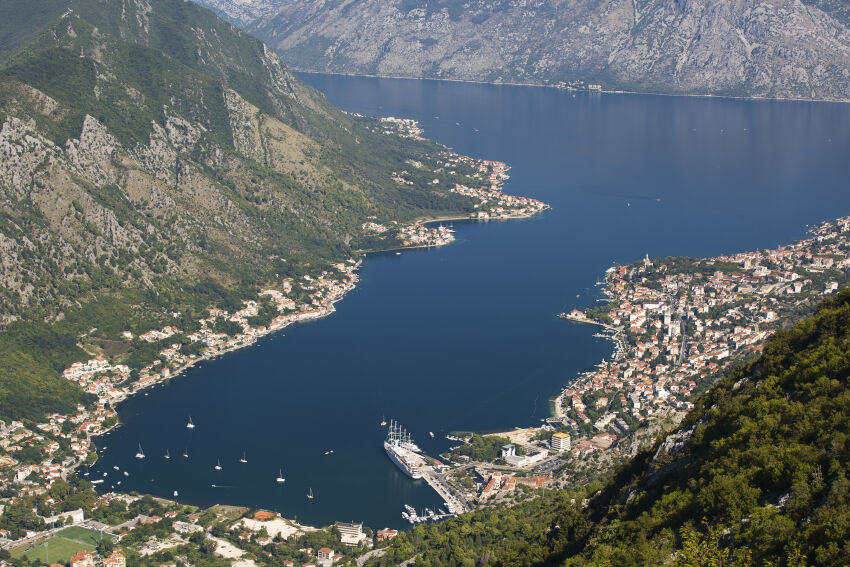
The only drawback of Kotor is the lack of good beaches. Basically, the beaches here are concrete piers with stairs for entering the water; in some places, the owners of nearby hotels and villas pour sand or pebbles, but such “man-made” beaches are broken by waves during the winter season of winds and have to be refilled every year.
The lack of beaches is not a problem for tourists from Western Europe, who love these places because of their unique topography. There is such a type of tourism as contemplation. It is believed that the main category of tourists visiting Kotor and its surroundings are Western Europeans. Many of them are even trying to buy houses here, which is why the Bay of Kotor has recently experienced a real construction boom.
Transportation Problem
Logistics around Kotor is very limited because of the narrow coastline, traffic along the sea is dense, and the roads are narrow. Remote villages of the bay, such as Strp, Morinj, Constanta, Prcanj, Stoliv, and the village of Lepetane, bordering Tivat, can be reached by local buses, which regularly depart from the stop in front of the Kamelia shopping center. The city has an intercity bus station, but it is significantly remote from the historical center of the city.
The main transport problem in Kotor for more than 10 years has been the lack of public parking and the “eternal” entry traffic jam from Tivat. Despite the authorities’ measures to regulate the flow of traffic using traffic lights and attempts to launch regular water transport for tourists around the bay, difficulties when entering the center began to be observed in winter, so those who come to admire Old Kotor or want to settle here need to be patient.
Architecture of Kotor
Let's do what the enemies of Kotor have failed to do for many centuries, let's take a look at what to see inside the city. This can be done through the fortress gates, which are located in the south, north and west of the fortress.
The architectural styles of buildings inside Kotor are divided into three main layers.
I. Serbian-Byzantine buildings made in the Romanesque style, mainly well-preserved churches and fragments of fortress walls from the 12th-13th centuries.
An excellent illustration of what fortification was like in the 12th “gunless” century is the fortress wall preserved at the southern gate of Kotor, located near the Gurdich bastion. Due to the fact that there was no threat of cannonball strikes at that time, the fortress walls were built low and vertical.
Among Roman churches, preserved in Kotor since the 12th century, the most popular one is the Church of St Luke.
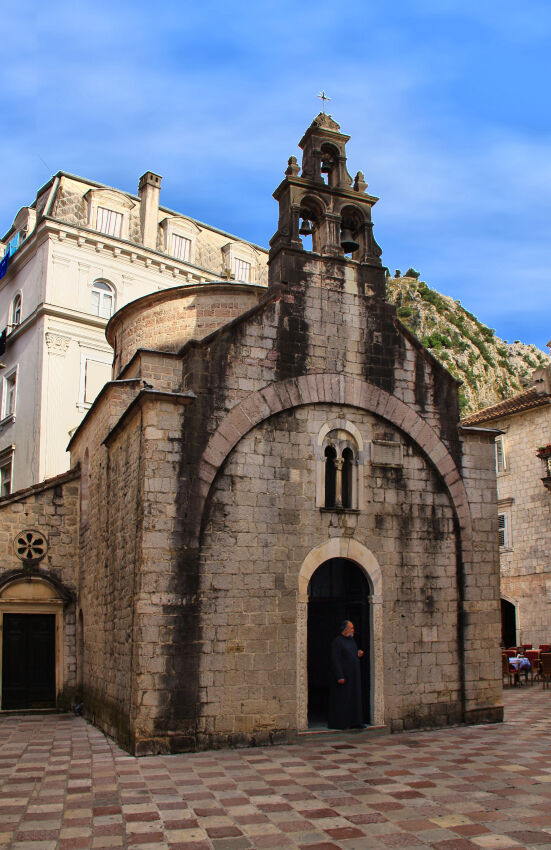
The Orthodox Church of St Luke is still working and inside this church fragments of Byzantine frescoes have been preserved, which may be of interest to lovers of antiquity.
In addition, be sure to find the Church of St Anne, also built at the end of the 13th century; exterior frescoes are visible on it, which is a rarity for churches of any era.
The largest religious building of the 13th century in Kotor is the Church of Mary of the River, located next to the River (Northern) Gate inside the city. The Church of St Michael is based on the appearance of an early Christian basilica, and a “lapidarium” is organized in it. Since 1906, a collection of stone coats of arms, stone decorations, slabs, portals, capitals have been collected here, i.e. everything that archaeologists found on the territory of Old Kotor.
The Church of St Michael in Roman-Gothic style
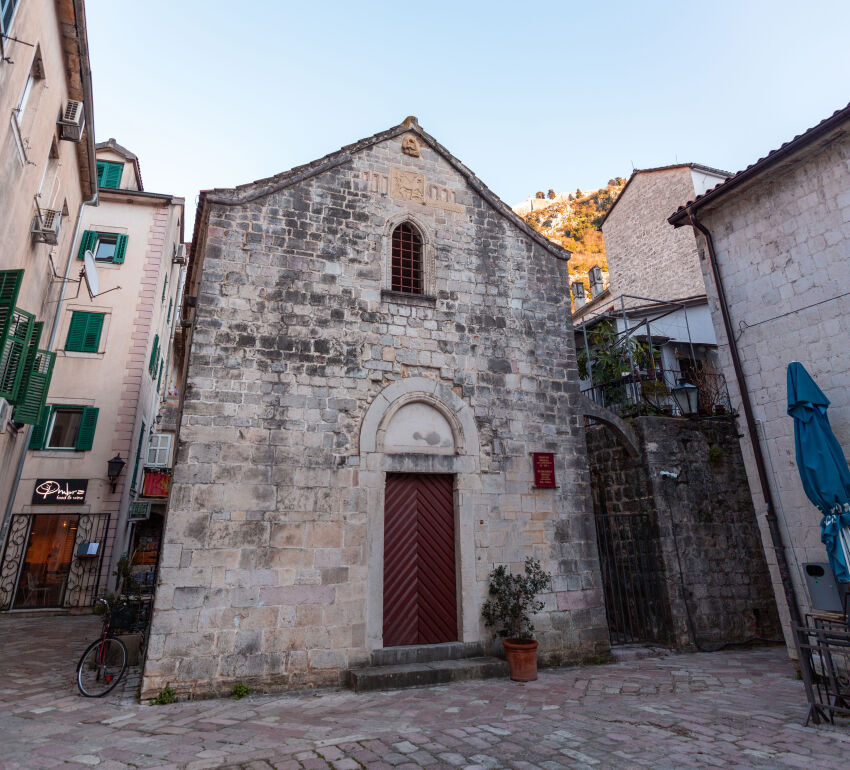
II. The next architectural layer of Old Kotor is Italian (Venetian) Baroque. It dominates inside the fortress, since the old city was almost completely rebuilt after the catastrophic earthquake of 1667, which destroyed almost all Gothic buildings. Since then, the Gothic has been present in the city only in fragments.
Probably the most beautiful Venetian chamber of Kotor from the Renaissance is the palace of the noble Pima family on Muki Square. Forged railings for the balcony of this Gothic-Baroque chamber, ordered from blacksmiths and gunsmiths, make many people linger in this square, where they used to bake bread and sell flour.
No less significant for the era of early modern architecture is the Cathedral of St Tryphon; its bell towers and the central part in the form of a giant arch acquired their baroque appearance also at the end of the 17th century. Old engravings tell us that the cathedral was originally Gothic in its architecture.
III. And finally, falling into the hands of the Austrians, in the 19th and 20th centuries the city got buildings for that era in the Art Nouveau style, which now stand out as bright spots in Old Kotor against the backdrop of the Italian Baroque that has dominated since the 18th century. The Orthodox Church of St Nicholas at the beginning of the 20th century was built in the form of a cross-domed Byzantine church.
The Church of St Nicholas is the complete architectural opposite of the Church of St Luke standing in front of it.
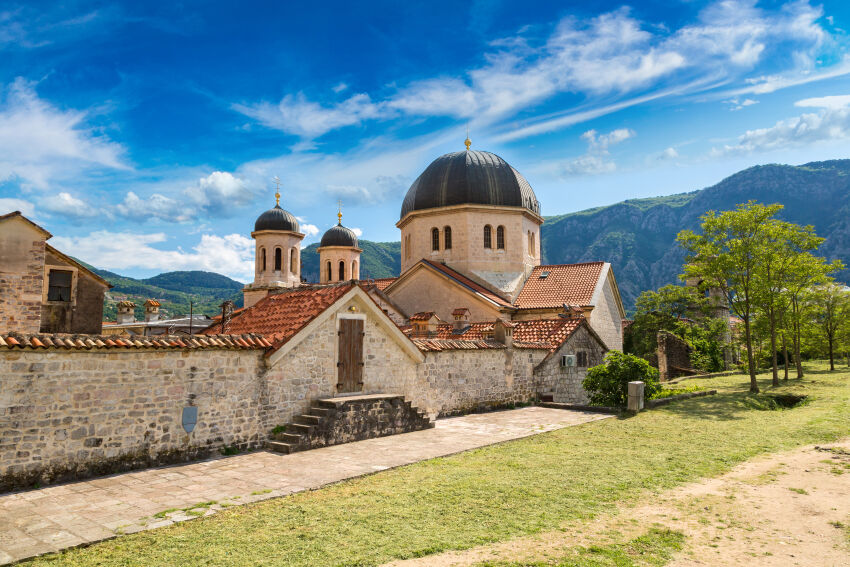
In the 20th century, the city lost its functions as a fortification, but, fortunately, during the times of Socialist Yugoslavia, the authorities began to realize the importance of developing tourism and banned new buildings, additions and superstructures within the old city. Moreover, another powerful earthquake that occurred here in 1979 made it possible to remove unnecessary historical layers and numerous architectural changes of the 19th and 20th centuries during the revival of Kotor.
Attractions and Places of Interest in Kotor
Old Kotor is rightfully the main tourist treasure of Montenegro. Its fortress and part of the towns adjacent to Kotor, located on the shores of the picturesque Boka Kotorska Bay, are included by UNESCO in the list of architectural heritage of mankind.
The Kotor fortress itself is divided by the relief into upper and lower parts, but 90% of tourists visit only “lower Kotor”, i.e. inhabited part of the Kotor fortress.
Only a few guests of this ancient city will dare to climb to the upper Fort of St John to a height of more than 200 meters along the many-kilometer fortress wall.
All popular places of Kotor are visible even from the lower fortress wall. Kotor hid all the sights within the perimeter of these walls; in fact, they are the main attractions of Montenegro.
Pay special attention to the city squares. There is Milk Square, Salad Square, Flour Square, and Weapon Square. All these remind us of the crafts and merchants who flourished in this city from the 13th to the 18th centuries; most of the city squares were built during this period.
Unfortunately, the earthquake of 1667 changed the plan of the city and many streets changed their direction, but the squares remained in place and stayed the main cells throughout the life of the city; be sure to visit these places.
1. The Gates of Old Kotor
Sea Gate decorated with a Venetian mask
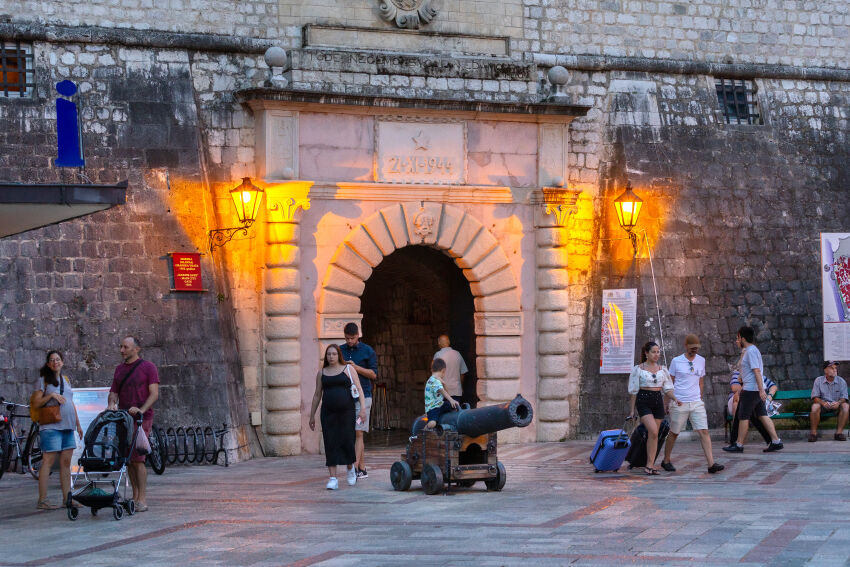
The gate now plays the role of a portal; when entering Old Kotor, it will take you to another world, the world of Italian Baroque, Venetian history, medieval life. Three gates are located in the lower fortress and one, now closed, was in the upper fortress, at an altitude of about 150 meters.
The northern gates are called the “Gate on the River”, these are the youngest city gates, they were built in the 16th century and served as access to the market, to which Montenegrins brought their goods from the mountains. The gate also had a military purpose, to make forays if the enemy landed on the banks of the Shkurda River.
And finally, the Sea Gate, located on the western side of the fortress, is now the main and most noticeable. It is through them that numerous groups of tourists enter, and behind these gates the Square of Arms with a clock tower and a pillory is located. Right there, on the Square of Arms, there are many cafes and shops; for many tourists a visit to Kotor ends with this square.
2. The Castle of San Giovanni
Fortress walls of the Castle of San Giovanni (St John)
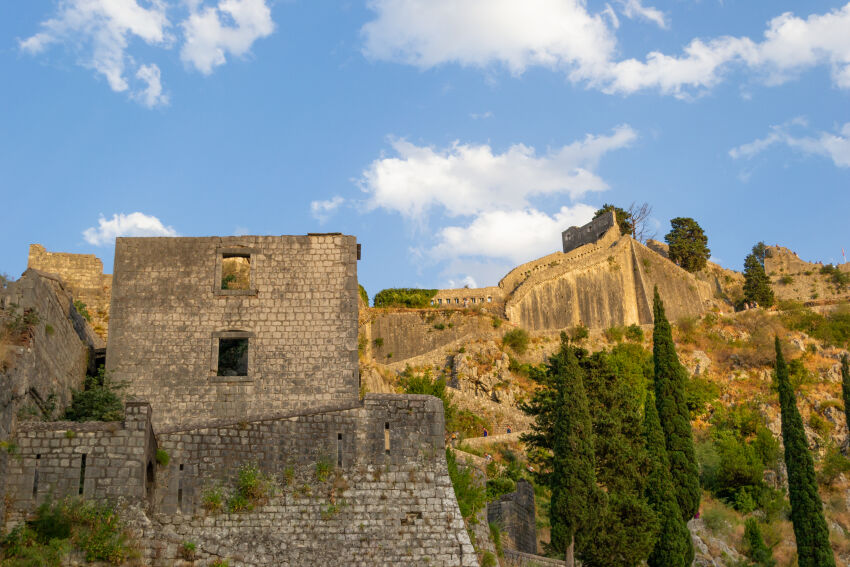
According to the rules of medieval fortification, a Donjon had to be built in every fortress of that time, i.e. the main city tower or an entire castle, where in the case of an enemy breakthrough through the outer walls of the fortress, the prince and his family could take refuge.
The castle of San Giovanni is a classic “donjon” of the Kotor fortress, but has a very unusual appearance and location at an altitude of 260 meters above sea level. If at sea the key fortification of the fortress was always the Campana bastion, then the castle of San Giovanni was the base for defense in case of attack from the mountains and the continent.
It was connected to the rest of the fortress walls by a folding bridge; on its territory, even now you can see the remains of a tank for drinking water, living quarters, warehouses for gunpowder, provisions and ammunition.
San Giovanni received its final appearance at the end of the 15th century, and the walls leading to it were modified by Venetian engineers in the 16th and 17th centuries.
Tourists can climb to the Castle of San Giovanni along the fortress walls; entrance to the upper fortress is paid. On the way to the castle there are almost one and a half thousand steps, a church of Mother of God on Zdravlja.
3. Boka Kotor Bay
There are 4 large cities on the shores of the bay
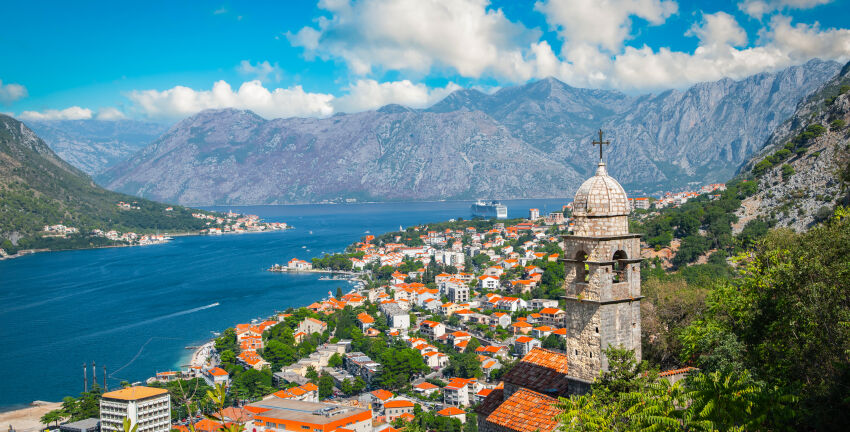
The roadstead in front of Kotor is almost always occupied by cruise ships, due to the 30-meter depth of the bay this is possible. The extension of the Boka Kotor Bay in this place is called “Kotovsky Bay” and the place itself has a very beautiful landscape, which is formed by the Dinaric Mountains hanging over Kotor and the Vrmac peninsula.
For some experienced travelers, these places are reminiscent of their beauty like lakes Garda and Como in northern Italy, for others, the Norwegian fjords. Yes, the combination of Venetian baroque architecture, amazing rocky landscape and cruise ships regularly coming from the sea make these places in Kotor truly unique.
Boka Kotor stretches several tens of kilometers deep into the continent. On its shores there are 4 cities, which give the name to the extensions of Boka, called the Gulf. When entering from the sea on a ship or yacht, the Herceg-Nova Bay awaits the traveler; after the narrow Kumbor Strait there is the Tivat Bay.
Further, passing through the narrowest Boka Strait, called Verige, the traveler will see the city of Perast and its two islands in front of him, the Risan Bay will open to the left, and the huge Bay of Kotor will stretch into the distance on the right. All cruise ships head along it exactly there, to the mysterious Kotor.
4. Pestingrad Rock Massif
Slopes of Pestingrad and Vilinitsa cave
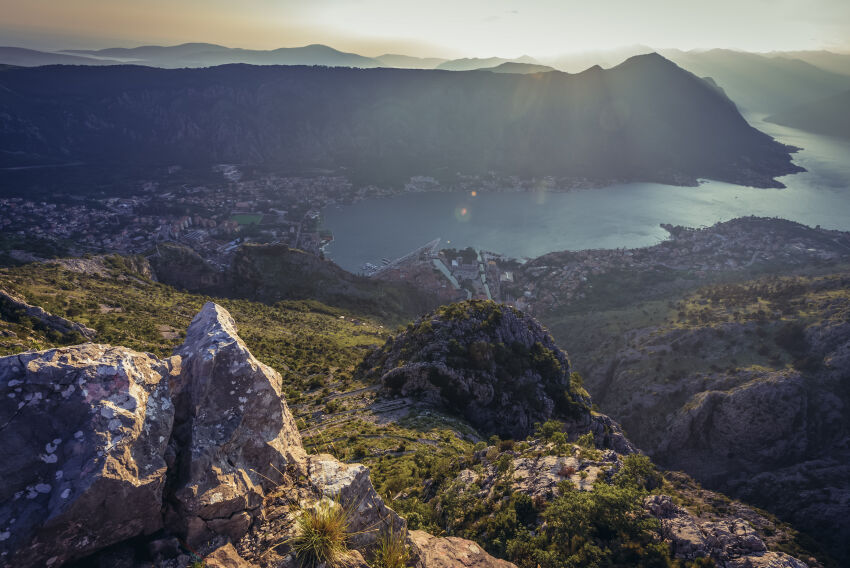
The rock massif hanging over Kotor from the south-eastern side is called Pestingrad. Adjacent to it is Mount Lovcen, which is key for Montenegro in a historical sense.
The Pestingrad rock, which every visitor to Kotor can easily see, is fraught with many legends associated with the history of the city. For example, one of the rocks of Pestingrad, fancifully split by nature in the form of an arch, is called the Gate of Vilas. Vilas are Serbs and Montenegrins, in the mythology they are good fairies and nymphs who helped wounded or strengthless warriors and travelers, living in the mountains and forests.
So, on the slopes of Pestingrad the Vila Alkima lived. The sailors who arrived in the bay wanted to found their city here, on the high and inaccessible rock of Pestingrad, but Vila Alkima advised them to build a fortress closer to the water and, by her will, springs with clean water appeared at the foot of Pestingrad, and the Shkurda River also jumped out from under rocks, although previously it flowed into the hidden bay, underground.
Since then, high in the mountains through the natural arch “Vilina Gate”, residents of the Kotor suburbs Dobrota and Prcanj can often see the crescent moon or the full moon. Closer to dawn, precisely on the full moon, when the moon, completing its night journey across the sky, shines from this arch, the “chosen ones” can see Vila Alkima on Mount Pestingrad, sitting on the arch of her gate. She still looks after Kotor and helps its inhabitants during difficult times.
Hiking trails lead from the village of Njegushi to the Pestingrad rock; the one-way road will take you about 2.5 hours. The trail is moderately difficult, it is better not to go there with children. At the end of the hike, there will be a kilometer-long cliff under your feet, a breathtaking view of the entire Boka Kotor and Kotor itself. There, going a little to the side, you can go through the Vilina Gate, but no one knows whether Vila Alkima will meet you and whether she will be glad to see you.
5. Citadel (Campana Bastion)
Campana Tower is a key citadel in the fortification of the Kotor fortress.
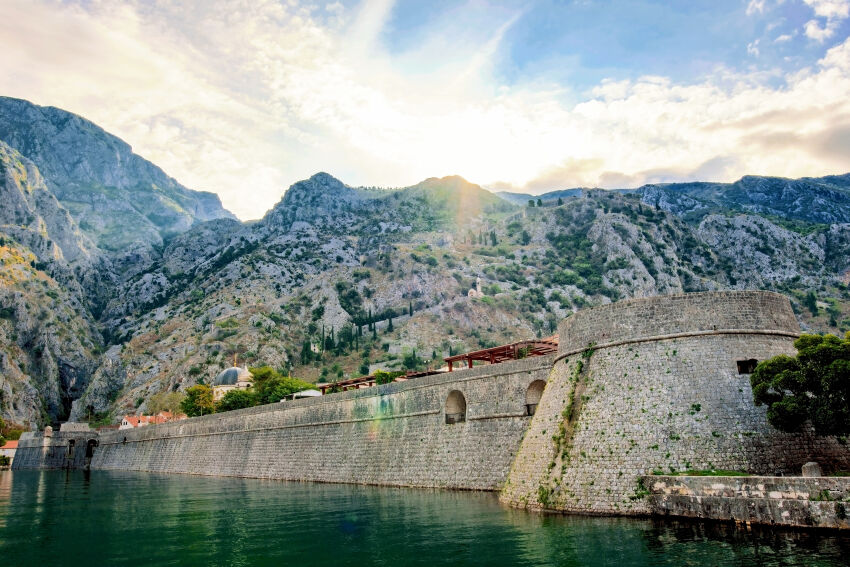
The Kotor Bastion or Campana Bastion is located on the key ledge of the city fortress, directed towards the Gulf. The bastion played a key role in repelling the attack of the troops of the Turkish admiral Khairuddin Barbarossa in 1539. At that time it was a round autonomous fortification, a “torrion grande”, connected to the city by a folding bridge.
In 1613, an artillery platform was created next to the Campana bastion, called the “position of Sorrano”, and 2 artillery batteries were placed on it. Interestingly, the position of commander of the Kotor citadel was so important that he was elected at the vote of the small Assembly of Kotor, along with judges and other officials.
Now tourists can freely climb the Kotor Campana citadel past the Napoleon Theater. From the Campana Bastion you can admire views of the Boka Kotor, the piers of Kotor and the bed of the Shkurda River. There are also tables at the Bastion cafe, where you can have a snack or just drink coffee with a beautiful view.
6. Cathedral of St Tryphon
The Church of St Tryphon is the center of the local Catholic bishopric.
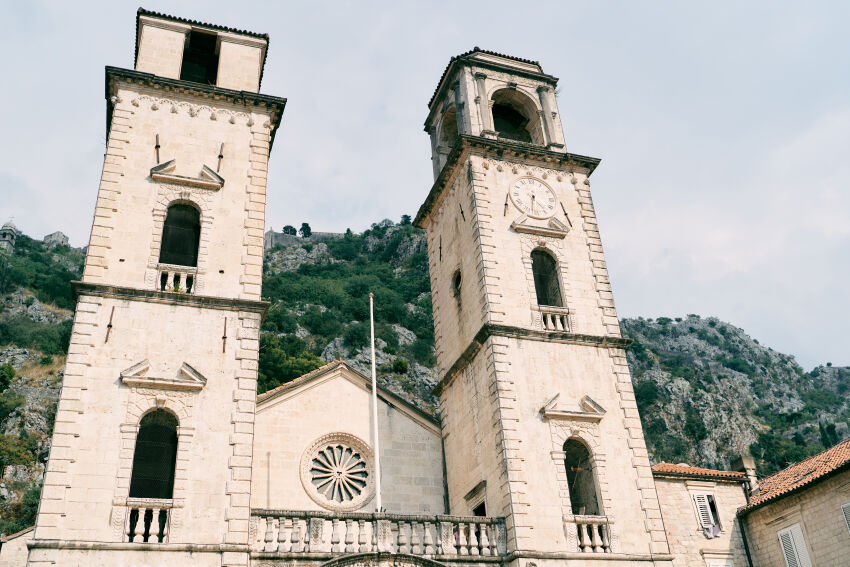
The main church of Kotor, the Cathedral of St Tryphon, has a long history. On stone inscriptions inside the cathedral, scientists discovered the date January 13, 809, which is considered to be the date of the consecration of this church.
In this church Andria and Maria Saratsenis, the patrons of the church, are buried. Their money was used to buy the relics of St Trypun (in the Orthodox tradition he is St Tryphon) from merchants at the beginning of the 9th century. The relics are now the main treasure of both the main city church and Kotor itself.
In the sacristy of the cathedral, which can be visited for a fee, you can see many artifacts from the religious life of Catholics from all periods of the life of the city and the temple itself, there are the clothes of bishops, dishes, religious objects, icons.
Externally, the Church of St Tryphon now represents a mixture of Roman and Gothic architectural styles with fragments of Baroque. The two 35-meter bell towers of the temple are easily visible from any part of the city; you can easily find it even without a city map.
Above the entrance to the church you will see the “golden boy”, this is Saint Tryphon, the patron saint of Kotor, whose relics the church keeps in its treasury. Take a closer look, in the hands of the golden Saint Tryphon he holds the whole of Kotor, which is depicted along with the upper fortress and the easily recognizable castle of San Giovanni.
The residence of the Catholic bishop is located in the adjacent church building. The bishop has access directly to the temple itself from his residence; he does not have to go outside. Such secret passages add more secrecy to this mysterious and most beautiful Catholic church in Montenegro.
7. Square of Arms
On the square there is the building of the city arsenal, where weapons were stored.
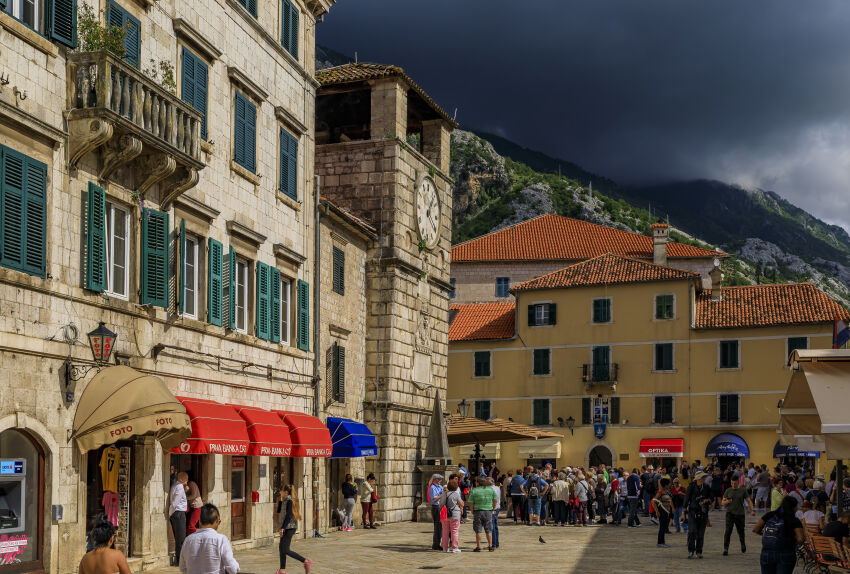
If you enter Kotor through its main “Sea” gate, you will immediately find yourself in the main city square, now called “Square of Arms”. The square had many names throughout its history; during socialism it was called October Revolution Square; in the 19th century it was “Vechnitsa”, i.e. the place where The Big Veche, the city parliament, used to meet.
It got its name “The Square of Arms” due to the blacksmiths and gunsmiths who worked on this square in various workshops. Besides the gunsmiths on the Square of Arms, Kotor jewelers had already been working with other metals. They were such brilliant masters that the altar of the Basilica of St Nicholas, opposite Montenegro on the other side of the Adriatic Sea in the city of Bari, was entrusted to them to decorate.
Weapons were given to all citizens of Kotor, since all male residents were obliged to stand on the fortress walls when attacked by the enemy. The city's war galleys were also armed from the arsenal of Kotor.
And, of course, on the main square of the city there is a clock tower and a “pillory”, to which the townspeople were put for small strengths, and decrees of more serious punishments were read out to the ranks.
You can easily see the main square of Kotor if you sit at a table in one of many cafes on the Square of Arms. At the local Forza Cafe you can try the best cheesecake in town.
8. Clock Tower and Pillar of Shame
The clock is still working and showing the exact time.

No one in the city could tell you when the “Stub Srama”, which means the Pillar of Shame, appeared. It has always been here. Citizens who committed minor crimes, now called “administrative”, were put on the Pillar of Shame. The period of standing at the Pillar of Shame could vary from several days to several weeks.
But the clock tower adjacent to it has the date of its birth, 1602. It was built on the execution site, where, after the verdict, death sentences or other executions were carried out. For example, at the place of execution, thieves had their hands cut off, and traitors had labels on their foreheads.
Now the Kotor Clock Tower is interesting not only because it is a recognizable symbol of the city. The history of Kotor and its clock tower have been inseparable for many centuries.
Just like several centuries ago, the city clock tower and the clock mechanism are maintained by the Homen family; the craft of watchmakers is passed on in this family from grandfather to son, from son to grandson. And the strikes of the city clock at noon can be compared with the heartbeat of both the city and Lubomir Homen, the modern keeper of the city clock.
9. Napoleon’s Theater
The building of the former Napoleon’s Theatre, one of the first theaters in the Balkans
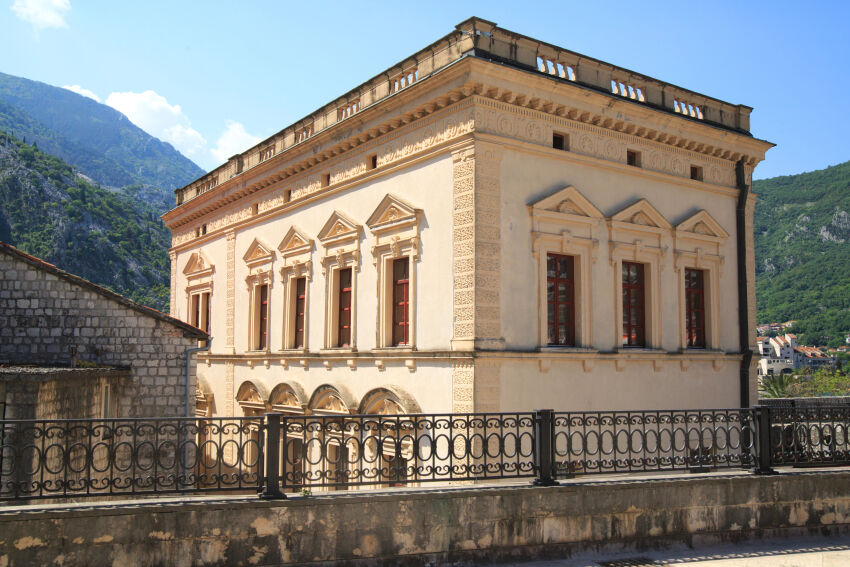
Next to the city arsenal on the Square of Arms in the Kotor you can see the building of the “Napoleonic” theater, which now houses an expensive hotel with a very beautiful foyer, stylized in the 19th century. Be sure to look through its glass inside the hotel lobby, it will become a real time machine for you. Many Dalmatian families visited Kotor and went to this theater.
The history of the theater began at the beginning of the 19th century, when Kotor was captured in 1807 by the French. One of the most cultured nations of this era, the French could not imagine their life without theater, and it was built on the site of the city guard building.
But the building of that theater, which gave performances until the end of the 19th century, unfortunately, does not have anything in common with a modern building of the classic style. It was built in the first half of the 20th century, when the Yugoslav authorities recreated the City Assembly on the site of the theater; at that time it was called the City Skupština. The theater building in Kotor was heavily damaged during the 1979 earthquake, but thanks to the work of restorers, it is now the most noticeable building in the city’s main square — Square of Arms. Past the “Napoleonic” theater you can climb the city walls and get to the Campana city bastion, from where there is a nice view of the Bay of Kotor and the surrounding area of Kotor.
10. Cats Museum
Cats museum in a private flat.
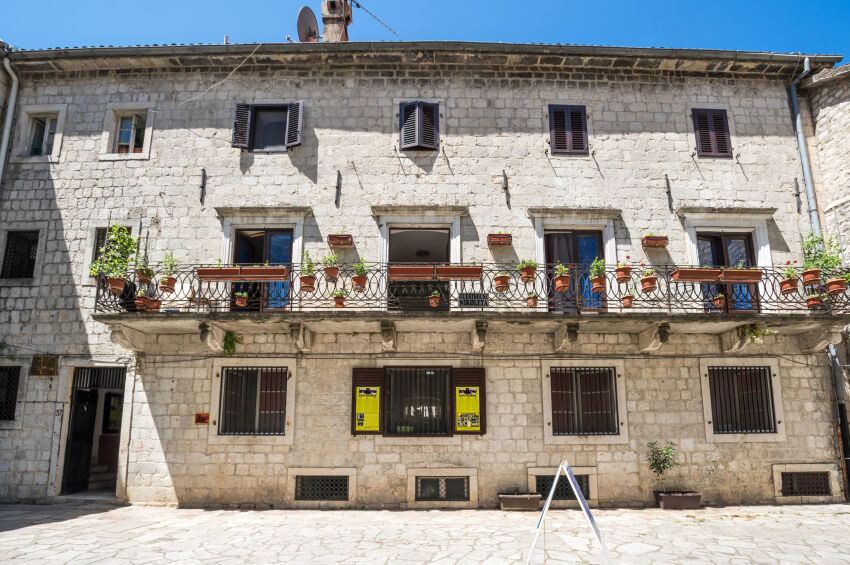
Probably the main disappointment you can face when visiting r the city is the Cats Museum. The Cats Museum is a private institution and its exhibition consists of several dozen exhibits. There are framed collections of postcards from different times depicting cats and their owners on the walls of the museum. On the museum display you can see several saucers and medals with images of cats, for children and adults paintings with a “cat” theme, nothing more.
Recently in Kotor cats have become a real symbol of the city,many “cat” souvenir shops have opened, where you can buy cats depicted on bags, T-shirts, in the form of magnets and figurines. In connection with this the private “museum” was opened.
The Cats Museum is located on Tree Square. The huge Elm, after which the square got its name, was planted here back in the 17th century, and when looking for the Cats Museum, you won’t miss it if you come to this huge elm.
The Map of Attractions in Kotor
The main sightseeings of Kotor are located compactly, you can find them on this map.

Conclusion
The main inconvenience when visiting Kotor is created by cruise ships, since each ship brings on board thousands of tourists who fill the streets of Old Kotor, its interesting places, and climb the walls of its fortress.
In connection with this, the recommended time for visiting the historical part of Kotor is from 8.00 to 11.00, before the arrival of groups from cruise ships and after 16.00, when cruise ships depart for the night passage to the next city along the cruise route. It is best to visit Kotor and the things to see there during the low tourist season, in winter, early spring or late autumn. It does not lose its charm in the “low season”, and the absence of tourist crowds allows you to carefully examine the Venetian chambers and cozy squares, to feel their spirit and charm.
Thus, if you only have one day to visit Kotor, then you simply must see the Square of Arms. Order a cup of coffee from a local cafe and watch the traffic in Kotor's main square. The Napoleon theater, the Sea Gate, the clock tower and the pillory — you can see all the sights at the same time.
Afterwards, walk past the theater to the city Citadel with the Campana bastion. Walk from the Citadel to the Bembo Bastion along the lower city wall, with a huge rock called Pestingrad looming over your head. Somewhere, in the caves of Pestingrad, the guardian of Kotor Vila Alkima is hiding.
If you have warmed up on the lower wall of the Kotor fortress, then you can begin to storm the upper wall, which leads to the castle of San Giovanni.
The road to this castle will take you 1.5-2 hours, depending on your preparation. Remember that the steps on the upper fortress wall are made of stone and can be slippery.
You can end your one-day hike in Old Kotor with the ringing of bells in front of the Church of St Tryphon or in the Cats Museum, here, as they say, what the soul asks for. You can leave the city through the South Gate of Kotor if your path lies towards the bus station.

